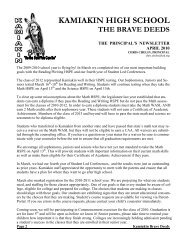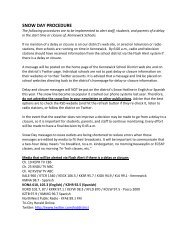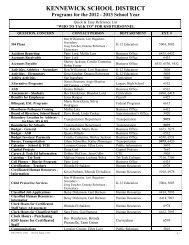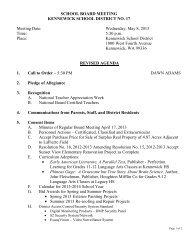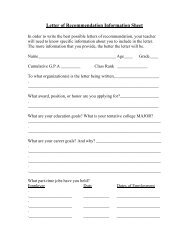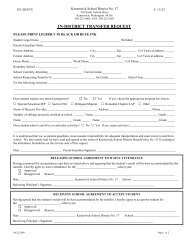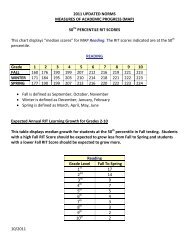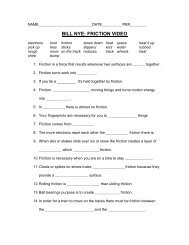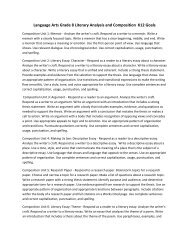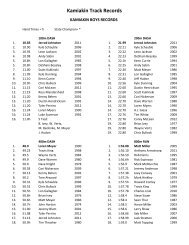4 4 Everyday Forces 4 Everyday Forces
4 4 Everyday Forces 4 Everyday Forces
4 4 Everyday Forces 4 Everyday Forces
Create successful ePaper yourself
Turn your PDF publications into a flip-book with our unique Google optimized e-Paper software.
4 4 <strong>Everyday</strong> <strong>Forces</strong>
Weight<br />
• Weight: the magnitude of the force of gravity<br />
acting on an object (scalar)<br />
• W=mg (Weight = mass x freefall acceleration)<br />
• Force of gravity, F g , is a vector
Practice<br />
• A 4 kg book is dropped on Earth<br />
• What is its acceleration?<br />
• What is its weight?<br />
• What should it weigh on a planet where g is 3.5<br />
times Earth’s gravity?<br />
• A 5 kg book is at rest on a table<br />
• What is its acceleration?<br />
• What is its weight?
Normal Force<br />
• Normal force: a contact force exerted by one<br />
object on another in a direction perpendicular<br />
to the surface of contact<br />
• F n or N<br />
• F n is NOT always equal to F g<br />
• F n and F g are NOT actionreaction pairs
Force of Friction<br />
• Friction opposes the applied force<br />
• Friction opposes motion<br />
• Friction depends on surface contact<br />
• Air resistance is a form of friction<br />
• F R is proportional to speed<br />
• Terminal velocity: freefall where F R =F g
Static Friction<br />
• Static friction: the force exerted on a motionless<br />
body by its environment to resist an external<br />
force<br />
• As the applied force increases, the force of static<br />
friction also increases until it reaches its<br />
maximum value<br />
• F s ≤ μ s F n (Static force of friction ≤ coefficient of<br />
static friction x force normal)<br />
• F s,max = μ s F n (Maximum static force of friction =<br />
coefficient of static friction x force normal)
Kinetic Friction<br />
• Kinetic Friction: the force exerted on a moving<br />
object<br />
• Kinetic friction is less than static friction<br />
• F k = μ k F n (Force of friction = coefficient of<br />
kinetic friction x force normal)
Practice<br />
• It takes a force of 80 N to set a 22 kg crate in<br />
motion. Find the coefficient of static friction.<br />
• If it takes only 65 N to keep the same crate<br />
moving at a constant velocity, what is the<br />
coefficient of kinetic friction.
Practice<br />
• A museum curator moves artifacts into place.<br />
Find F s,max and F k to move a 120 kg aluminum<br />
statue across a steel floor if μ s =0.61 and<br />
μ k =0.47.<br />
• Note: a table of coefficients can be found on<br />
page 144
Practice<br />
• A box weighing 400 N moves with a constant<br />
velocity across the floor when it is pushed with<br />
a force of 500 N exerted downward at an angle<br />
of 35° below the horizontal. Find μ k between<br />
the box and the floor.
Practice<br />
• A student moves a box of books down the hall<br />
by pulling on a rope attached to the box. The<br />
student pulls with a force of 150 N at an angle<br />
of 20° above the horizontal. The box has a<br />
mass of 30 kg, and the μ k between the box and<br />
floor is 0.25. Find the acceleration of the box.
Practice<br />
• A 10 kg bag of groceries is in equilibrium on<br />
an incline of angle Ө = 20°. Find the normal<br />
force of the incline on the bag.
Practice<br />
• A 80 kg box slides down a 20° ramp with an<br />
acceleration of 1.5 m/s 2.<br />
• Find μ k between the box and the ramp.<br />
• Find the acceleration a 175 kg box would have on<br />
this ramp.



